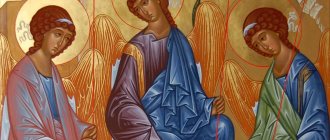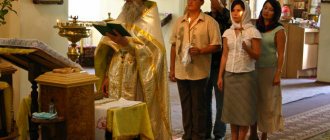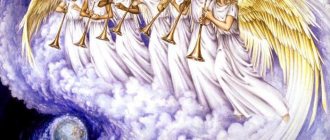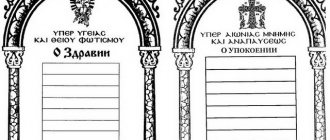WORSHIP CIRCLES
Liturgical circles
- a certain repeating sequence of services or prayers that compose them.
Daily cycle of worship
Daily liturgical circle
- sequence of services for one day. The liturgical “days”, according to the Old Testament tradition (“And there was evening, and there was morning—one day,” etc.) begin in the evening (and not from midnight, as is customary in the civil calendar) and consist of the following rites (in parentheses the conditional time of their occurrence according to modern time calculation is indicated; in practice it can be significantly different):
- Ninth hour (15 o'clock)
- Vespers (6 p.m.)
- Compline (21:00)
- Midnight Office (24 or 0 hours)
- Matins (3 hours)
- First hour (6 hours)
- Third hour (9 o'clock)
- Sixth hour (12 noon)
- Liturgy [1]
This order changes on days when the All-Night Vigil is celebrated (Compline and Midnight Office are omitted), some days of Great Lent, as well as on the eve of the holidays of the Nativity of Christ and Epiphany.
At present, the order of the daily liturgical cycle in parish practice is usually not observed - the ninth hour, Compline and Midnight Office are omitted. The services of the daily liturgical circle are contained in the Book of Hours.
Weekly (weekly) circle of services
Weekly liturgical circle
- a thematic sequence of services within one week.
Each day of the week is specifically dedicated to a specific topic:
- Sunday - Resurrection of Christ.
- Monday is the glorification of the ethereal forces of the Angels.
- Tuesday - Glorification of St. John the Baptist and the prophets.
- Wednesday is the remembrance of the betrayal of Judas (and since this essentially began the time of the Passion of the Lord, the service of the Cross is performed, and the day is fast).
- Thursday - Glorification of Sts. Apostles and St. Nicholas the Wonderworker.
- Friday - the remembrance of the sufferings on the cross and the death of the Savior; service of the Cross, fast day).
- Saturday is the glorification of the Mother of God and all the saints. The deceased are also remembered.
Eight-week osmotic circle of worship
The divine service of the weekly liturgical circle is subordinated to one of the eight voices, etc. Eight-week vocal cycles are formed, repeated several times throughout the year. The counting of voices begins on Easter Day with the first tone. The services - a set of variable components of the divine service of the weekly liturgical circle - are contained in the octoech. See also osmoconciliation.
Annual circle of services (fixed and moving)
Annual liturgical circle
— a thematic sequence of services throughout the year. There are different types of movable and fixed annual liturgical circles.
Fixed annual liturgical circle
- associated with the solar calendar - includes the worship of the fixed twelfths and other holidays and the daily celebrations of saints.
Movable annual liturgical circle
- associated with the lunar calendar (see Easter) - includes the services of Great Lent (and the three preceding weeks), Pentecost and Octoechos.
The services of the fixed annual liturgical circle are contained in the menaions, the moving ones - in the Lenten Triodion (Lent), the Colored Triodion (Pentecost) and the Octoechos.
The connection of the moving and fixed annual liturgical circles is carried out using the Markov chapters given in the charter (named after their compiler, monk Mark). The divine service of each day is a combination of an almost unchanging basis from the prayers of the daily liturgical circle with changing prayers related to the liturgical theme of the given day from the Menaion and Octoechos or Triodion (Lenten or Colored), and during Lent and Pentecost, prayers from the Octoechos are almost not used.
Eleven-week circle of Gospel readings and stichera at Sunday Matins
A circle that is usually “forgotten” when listing liturgical circles... For reading at Sunday matins, 11 fragments [2] were selected from all four Gospels, telling about the events after the Resurrection of Christ. These fragments are read one by one (the number is always indicated in the liturgical calendar). Each of these 11 fragments is associated with its own special “gospel stichera,” which should be sung to “glory” after the stichera on the praises.
[1] The Eucharist, as a sacrament of the Kingdom and the Future Age, is, as it were, outside of this time, and therefore does not have a specific time of celebration in the daily circle. In most cases, the Liturgy is celebrated after the Sixth Hour, less often after Vespers. More details in the article “Liturgy”
[2] The number 11 symbolizes the eleven remaining apostles at that time - after the fall of Judas Iscariot and before the election of Matthias
Monday
If we look further at the weekly circle, we will note the consistency and internal logic with which it is built. Throughout the week, the Church remembers the events of the Old and New Testaments, starting from the very creation of the world. The Heavenly Ethereal forces were created before man, which is why the Church remembers them first of all.
The word “Monday” itself means “after the week” - the second day after Sunday. On this day, the Church prayerfully commemorates the Archangels and Angels and all the Heavenly powers, to whom the Lord entrusted to protect man and help him in doing good deeds. The troparion of the day reveals the meaning of the heavenly intercession of the Ethereal forces: “Heavenly armies of the Archangels, we always pray to you that we are unworthy, that with your prayers protect us, with the shelter of your immaterial glory, preserving us who fall diligently and blatantly, deliver us from troubles, like the rulers of the Highest Powers.”
The Service to the Ethereal Forces includes three stichera on “Lord, I cried” and a second canon read at Matins, written by the confessor Theophan the Inscribed.
In some Russian monasteries there is a tradition of fasting on Mondays as well. Monks imitate the Angels, devoting their lives to serving God and praising His Heavenly Glory, which is why they especially celebrate the day of honoring the Ethereal Powers.
Neo-Savat Synthesis – Mount Athos and Slavic Churches
New horizons of development are opening up for the daily liturgical circle and the Book of Hours, which gradually introduces new changes into the services. The studio synthesis reaches Jerusalem and many of its elements, especially those that come from the rite of song, bring, on the one hand, the enrichment of worship and solemnity, and on the other hand, immersion in the theology of the liturgy, and become accepted until then strict, simple and laconic desert Savvaitic tradition.
This latest Neo-Sabbatic version of the daily liturgical cycle will come again to Constantinople, as well as to the monasteries of the Studite tradition, which was caused by the flight of many monks from Palestine after the capture of Jerusalem in 1009 by Caliph Al-Hakim and the destruction of the Temple of the Resurrection, as well as the subsequent further misfortunes of the Eastern Church, caused by the advance and settlement of the Ottomans.
Nikon Mavrorit (1025–1088) was the first to note and record the main differences between two statutes of the same, let us emphasize, Palestinian origin: Savvaite and Studite.
The fall of Constantinople and its passing into the hands of the Latins in 1204 would deal an irreparable blow to all areas of life in the Byzantine Empire. New unfavorable historical conditions in the capital will make it impossible to use the song sequence, while at the same time they will inevitably lead to the withering of monastic life both in the Studite Monastery and in other monasteries in the capital region, as well as in significant monastic centers of Asia Minor.
At the same time, we see the flourishing of Athonite monasticism, which, despite the initial dependence on the exclusively Studite tradition, from the 13th century began to gradually accept the Neo-Sabbatic synthesis. The Lavra hesychast spirit of Palestine will eventually prevail over the urban cenobitic studite monasticism to such an extent that the Neo-Savvaite liturgical tradition will be fully accepted by the Athonite Typicons of the 14th century, and it will completely prevail in them in the 15th century.
Saint Simeon of Thessalonica explains: “Other other services of the statute of the Great Church... are not performed in the Christ-loving royal city due to its capture by the Latins... and due to the lack of many priests and choristers.” On the contrary, the same writer notes, the spread of the Savvaitic Rule throughout the Byzantine Empire is due to the fact that “with it it is possible to perform a service for one person, since it was compiled by monks, and often the service is performed without songs in cenobitic monasteries.”
Finally, with the triumph of hesychasm (1347 and 1351), hegumen of the monastery of the Great Lavra Philotheus Kokkin († 1379), student and biographer of St. Gregory Palamas, twice Patriarch of Constantinople (1353–1355, 1364–1376), codifies the New Savvaite liturgical tradition of Athos in the work “ Diataxis - Rules for the priestly service, or how the deacon and priest serve at Great Vespers, Matins and the Liturgy.” The diatax of Patriarch Philotheus will quickly spread throughout Athos and the dioceses of Constantinople. Southern Italy, the last stronghold of Studite influence, would adopt the Neo-Sabbaitic rite two centuries later, when the pope, by decree of 1587, ordered the monastery of Santissimo Salvatore in Messina to replace its Studite rite with the Savvaitic one.
The “Rule of Priesthood” of St. Philotheus will be translated into Church Slavonic before the end of the 14th century. In Russia, Metropolitan Alexy was the first to introduce the Savvaitic Rule into the Chudovsky Monastery he founded in 1365–1378.
A stage, a cross-section, a milestone in the liturgical life of Russia will be a work about the worship of a true hesychast, Metropolitan Cyprian, a disciple of Saint Philotheos (Kokkin), first on Athos (1364–1373), and then in Constantinople (1373–1375). Metropolitan Cyprian introduced the Savvaitic Rule into the Russian Church in 1378–1401, both in parishes and in monasteries. The widespread dissemination of the Savvaitic Rule, the compilation of the liturgical Psalter, as well as new liturgical books adapted to the Jerusalem rite, brought liturgical uniformity to the Russian Orthodox Church. The essay on the divine service of Metropolitan Cyprian was aimed, on the one hand, at hesychast renewal based on the foundation of the patristic monastic tradition, and on the other hand, at strengthening the unity of the Church of Constantinople with the Slavic Churches.
Monk Afanasy Vysotsky in 1401 compiled the first Russian Savvaitic charter, called “Eye of the Church”, in the monastery of the Mother of God Periveleptus in Constantinople, which sums up and combines various traditions: Savvaitic, Studite and Svyatogorsk.
The Trinity-Sergius Lavra in 1429 will adopt the New Savvaitsky charter, and then in 1441 it will be followed by Novgorod and in 1494 by the distant Solovetsky Monastery.
The Council of the Hundred Heads (1551) approved the liturgical work of Metropolitan Cyprian, while Patriarch Nikon in the middle of the 17th century made an attempt to harmonize the customs of worship of the Russian Orthodox Church with the books of the Greek-speaking Church, thus imposing and strengthening the existence of New Savvaitic statutory elements in Russian liturgical practice.
Saturday
Saturday is the last day of the week, and on this day the Church remembers all the saints. And the first among these saints is the Most Holy Theotokos. Of course, we glorify the Mother of God on any day of the week, but on Saturday She is especially revered. Also on this day, all our departed are remembered; the commemoration is combined with the remembrance of the presence of the Lord Jesus Christ in the tomb and His victory over death.
How did the weekly cycle of worship come about?
The origins of the formation of the weekly liturgical circle of the Christian Church should be sought in the Old Testament. The fourth commandment of the Mosaic law is: Remember the Sabbath day, to keep it holy; six days you shall work and do all your work, and the seventh day is the Sabbath of the Lord your God (Ex. 20:8-10). Saturday was perceived, first of all, as a day of rest, rest from work, in memory of the fact that in six days the Lord created heaven and earth, the sea and everything in them, and rested on the seventh day. On Saturday a sacred meeting was held (see: Lev. 23:3); On this day, burnt offerings (see: Numbers 28:9) and showbread (see: Lev. 24:8) were sacrificed to the Lord. In the era after the Babylonian captivity, Saturday becomes the main liturgical day of the week: on this day, Jews gather in the synagogue to pray and read the Holy Scriptures.
In Christianity, the Old Testament injunction to keep the Sabbath has undergone a radical revision. Christ did not reject this rule and Himself attended the synagogue on Saturdays (see: Luke 4:16), however, He allowed Himself to violate the order of Saturday rest, proving to the Jews that the Son of Man is the lord of the Sabbath (see: Mark 2:28 ). After His Ascension, Christ's disciples continued to attend church on Saturdays, but the first day of the week becomes the day of the Eucharist. Once the doors of the Church were opened to the Gentiles, Sabbath observance as prescribed in the Old Testament became meaningless.
Early Christian writers spoke of the Sabbath as one of the Jewish customs that died out after the coming of Christ into the world. The “life of the Resurrection” comes to replace the “Sabbath keeping.” This day was often called the “eighth day” - as a prototype of eternity. That is why we spend the eighth day in joy, on which Christ rose from the dead.
In the middle of the 4th century, the contrast between Sunday and Saturday was enshrined in the 29th canon of the Council of Laodicea: “It is not fitting for Christians to practice Judaism and celebrate on Saturday, but to do so on this day; and Sunday is primarily to be celebrated.”





